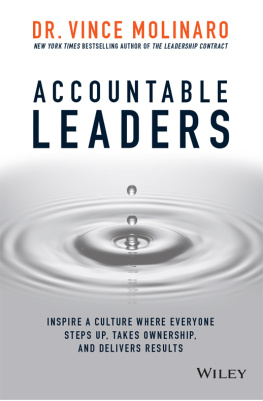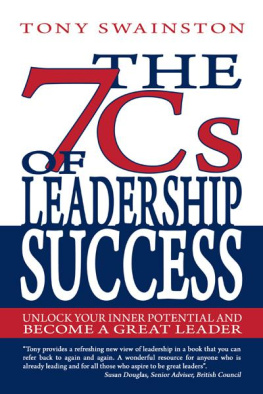CONTENTS

Cover image: Marie Nimrichterova / Shutterstock
Cover design: Wiley
Copyright 2013 by Vince Molinaro (of Knightsbridge Human Capital Solutions). All rights reserved.
Published by John Wiley & Sons, Inc., Hoboken, New Jersey.
Published simultaneously in Canada.
No part of this publication may be reproduced, stored in a retrieval system, or transmitted in any form or by any means, electronic, mechanical, photocopying, recording, scanning, or otherwise, except as permitted under Section 107 or 108 of the 1976 United States Copyright Act, without either the prior written permission of the Publisher, or authorization through payment of the appropriate per-copy fee to the Copyright Clearance Center, 222 Rosewood Drive, Danvers, MA 01923, (978) 750-8400, fax (978) 646-8600, or on the web at www.copyright.com . Requests to the Publisher for permission should be addressed to the Permissions Department, John Wiley & Sons, Inc., 111 River Street, Hoboken, NJ 07030, (201) 748-6011, fax (201) 748-6008, or online at www.wiley.com/go/permissions .
Limit of Liability/Disclaimer of Warranty: While the publisher and author have used their best efforts in preparing this book, they make no representations or warranties with the respect to the accuracy or completeness of the contents of this book and specifically disclaim any implied warranties of merchantability or fitness for a particular purpose. No warranty may be created or extended by sales representatives or written sales materials. The advice and strategies contained herein may not be suitable for your situation. You should consult with a professional where appropriate. Neither the publisher nor the author shall be liable for damages arising herefrom.
For general information about our other products and services, please contact our Customer Care Department within the United States at (800) 762-2974, outside the United States at (317) 572-3993 or fax (317) 572-4002.
Wiley publishes in a variety of print and electronic formats and by print-on-demand. Some material included with standard print versions of this book may not be included in e-books or in print-on-demand. If this book refers to media such as a CD or DVD that is not included in the version you purchased, you may download this material at http://booksupport.wiley.com . For more information about Wiley products, visit www.wiley.com .
Library of Congress Cataloging-in-Publication Data:
Molinaro, Vince, 1962
The leadership contract : the fine print to becoming a great leader / Vince Molinaro.
pages cm
Includes bibliographical references and index.
ISBN 9781118635575 (cloth); ISBN 9781118714782 (ebk); ISBN 9781118714744 (ebk)
1. Leadership. 2. Organizational change. I. Title.
HD57.7.M635 2013
658.4092dc23
2013010403
For Liz, Mateo, Tomas, and Alessia
INTRODUCTION
A former industry-leading innovator in the technology sector loses its market dominance in a matter of months and now struggles to survive. The chief executive officer (CEO) of a large retailer is forced to resign after having an inappropriate relationship with a coworker. The founder and chair of the board of the same company is pushed out after its revealed that he knew about the relationship and did nothing to inform the board. It seems that stories of corruption and scandal are now so commonplace that we dont even react anymore. Our sense of trust and confidence in senior leaders has been eroded. Survey after survey finds employee engagement is chronically, cripplingly low. Managers say the new generation of workers is unmotivated and feel entitled, while members of Generation Y say theyre simply not interested in rising through the ranks in the traditional way. Meanwhile, you and your colleagues feel overworked and pulled in about a dozen different directions at once.
These arent separate problems. I believe theyre all part of one crisis, a crisis that companies worldwide are spending an estimated $60 billion trying to solveand getting nowhere.
Its a crisis in leadership.
At a moment when our world is more complicated than ever, is changing faster than ever, and is more radically transparent than ever, we desperately need our leaders to be stronger than ever. And theyre not. Theyre failing us. And were becoming disillusioned.
Ive been studying leadership for 25 years. As an employee Ive worked for some great leaders and some who were not so great. I know firsthand the effect leadership has on employee engagement and organizational performance. As a consultant, Ive worked with thousands of leaders and hundreds of organizations. And Ive held leadership roles, and I currently hold an executive position at Knightsbridge Human Capital Solutions. I know at a personal level how challenging leadership can be if you want to do it well on a consistent basis. I also know how great it can be when you get it right.
I talk to leaders every day who know that the world has changed for them. Some feel they are not keeping up. Others believe there is something fundamentally wrong with how we have come to think about leadership. They know their organizations are struggling just to stay abreast of a changing world, and they know that in their desperation theyre settling . When everything on your to-do list is urgent, things such as inspiration and motivation seem like luxuries. You feel like the leadership parts of your role are just that: parts, something separate that you do from the corner of your desk.
But leadership is not a luxury. You cant settle, or you risk becoming lame. Your organization needs great leaders at all levels, now more than ever. You need to be the best leader you can possibly be. The issue is that leadership has changed, and you are now under more pressure than ever before. Lets look at a few of the big ones:
1. The Pressure to Differentiate: Whether its a private sector company or a public sector organization, every enterprise is trying to differentiate itself. All organizations have competitors, whether for market share or government funding, and now the competition is fierce. Whatever competitive advantage you thought you had seems to have a smaller and smaller shelf life, as rivals copy it almost overnight. You face unrelenting pressure to innovate and look for ways to stand out from the crowd.
2. The Pressure to Execute Strategy: You face tremendous pressure to execute strategy. If youve been a leader for a while, you know how hard this can besuccess is elusive for many organizations. Research repeatedly shows that only 10 to 30 percent of organizations ever succeed at executing their strategy. Our research at Knightsbridge suggests that part of the reason is that boards and executive teams spend a lot more time talking about what the strategy should be than about how to put it into practice. Many clients have also worked with large strategy consulting firms who do a good job of helping them create strategy but then leave without ever discussing how to get it done. Yet from where I sit its clear that theres a deep connection between strategy and leadership: Leaders create the strategy, and they need to work together to align the organization. Its their responsibility to ensure that everyone from the front line to the senior team understands the plan. Gaps in leadership will create gaps in execution.
3. The Pressure to Manage Complexity: A global study conducted by IBM of 1,500 CEOs found that complexity is a big challenge for leaders today. Eighty percent of leaders surveyed believed the future business environment is going to be even more complex than todays. Less than 50 percent were confident they would have the ability to deal with it. Complexity isnt just increasing, it is also accelerating. As a leader, you will need to help your employees and organization manage this heightened level of complexity in your business environment. You must also do it at a time when you feel like you have diminished power. The days of command and control are over, and now you must influence and bring stakeholders along with you as they try to manage the complexity in their own lives.










